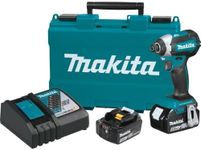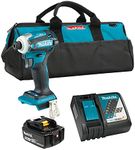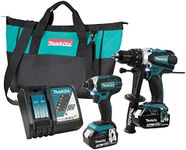Buying Guide for the Best Makita Impact Drivers
Choosing the right impact driver can make your DIY or professional projects much easier and more efficient. Impact drivers are powerful tools designed for driving screws and bolts with high torque, making them ideal for tasks like building decks, assembling furniture, or working on construction sites. When picking an impact driver, it's important to consider how you'll use it—whether for occasional home repairs or heavy-duty professional work. Understanding the key specifications will help you find a model that matches your needs and ensures comfortable, reliable performance.VoltageVoltage refers to the power output of the impact driver, usually measured in volts (V). Higher voltage generally means more power, which is useful for tougher jobs. Impact drivers typically come in 12V, 18V, or 20V versions. A 12V model is lighter and suitable for light tasks like assembling furniture or minor repairs. An 18V or 20V model offers more power and is better for heavy-duty work like construction or driving long screws into tough materials. Choose the voltage based on the intensity and frequency of your projects.
TorqueTorque is the force the impact driver can apply to a screw or bolt, measured in inch-pounds (in-lbs) or Newton-meters (Nm). Higher torque means the tool can handle tougher jobs and larger fasteners. Light-duty models may offer around 800-1,200 in-lbs, which is enough for most home tasks. Medium-duty models range from 1,200-1,800 in-lbs, suitable for more demanding DIY or renovation work. Heavy-duty models can exceed 2,000 in-lbs, ideal for professionals or those working with dense materials. Consider the types of projects you plan to tackle to decide how much torque you need.
Speed (RPM and IPM)Speed in impact drivers is measured in revolutions per minute (RPM) and impacts per minute (IPM). RPM indicates how fast the bit spins, while IPM shows how many times per minute the tool delivers its hammering action. Higher speeds allow for faster driving of screws, but too much speed can strip screws or damage materials. For light tasks, lower speeds are sufficient, while higher speeds are better for repetitive or heavy-duty work. Some models offer variable speed settings, which provide more control and versatility for different tasks.
Chuck Size and TypeThe chuck is the part of the impact driver that holds the bit, and most impact drivers use a 1/4-inch hex chuck. This size is standard and fits most screwdriver and drill bits designed for impact use. Quick-release chucks make it easy to change bits with one hand, which is convenient when working on projects that require different bit sizes. If you plan to use a variety of bits or switch frequently, look for a model with a quick-release feature.
Weight and ErgonomicsWeight and ergonomics refer to how heavy and comfortable the impact driver is to hold and use. Lighter models are easier to handle for extended periods and are less tiring, making them ideal for overhead work or long projects. Heavier models may offer more power but can be cumbersome. Ergonomic handles with good grip and balance help reduce fatigue and improve control. Consider how long you'll be using the tool at a time and whether you'll be working in tight or awkward spaces.
Battery System and RuntimeMost modern impact drivers are cordless and use rechargeable lithium-ion batteries. The battery's amp-hour (Ah) rating indicates how long it will last on a single charge. Higher Ah means longer runtime, which is useful for big projects or professional use. Some brands offer interchangeable batteries across their tool range, which can be convenient if you already own other tools from the same brand. Think about how often you'll use the tool and whether you need extra batteries for uninterrupted work.
Additional FeaturesSome impact drivers come with extra features like built-in LED lights, belt clips, or brushless motors. LED lights help illuminate dark work areas, while belt clips make it easy to carry the tool around. Brushless motors are more efficient, last longer, and require less maintenance. Decide which features will make your work easier or more comfortable, based on your typical projects and work environment.
















